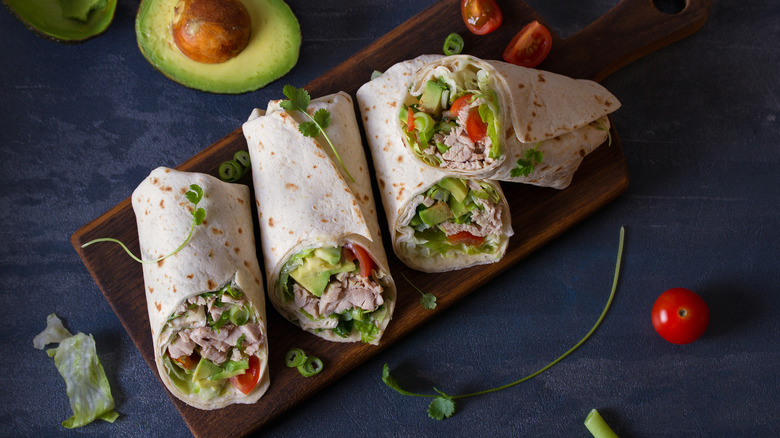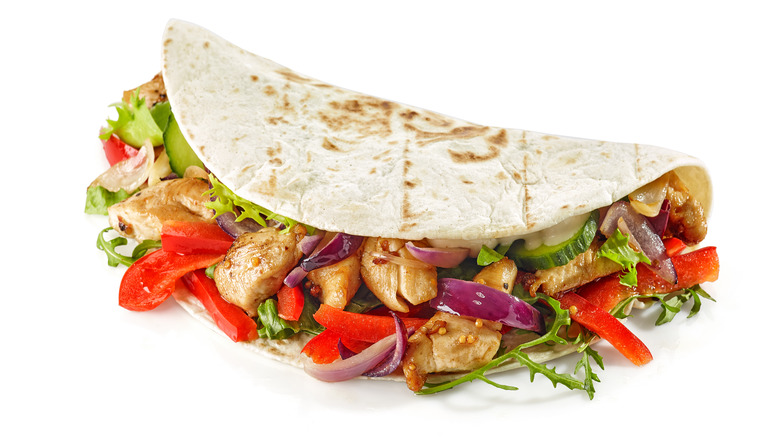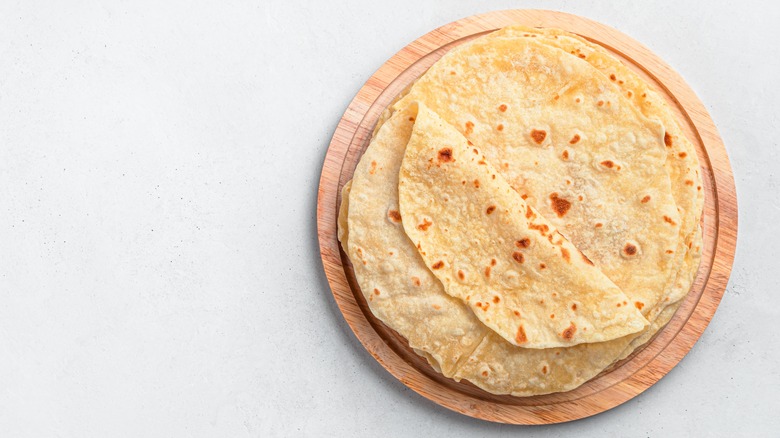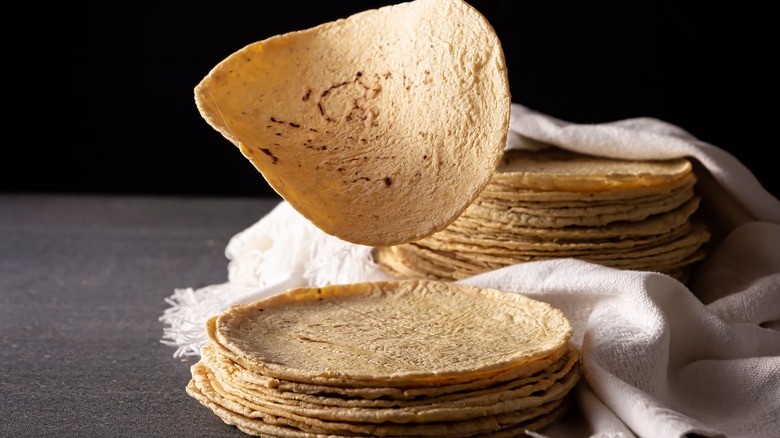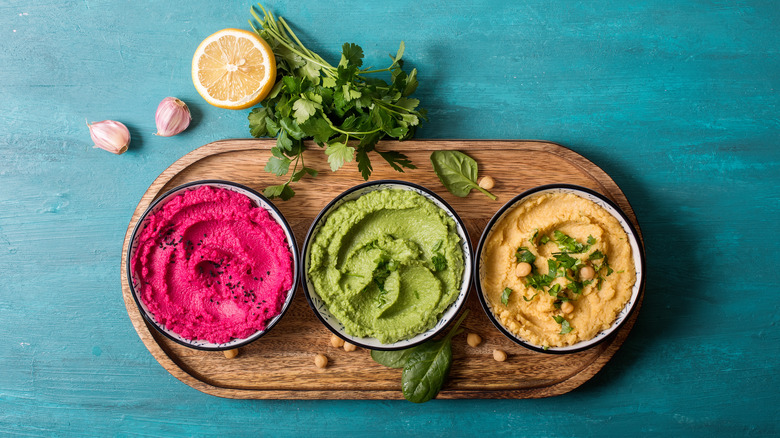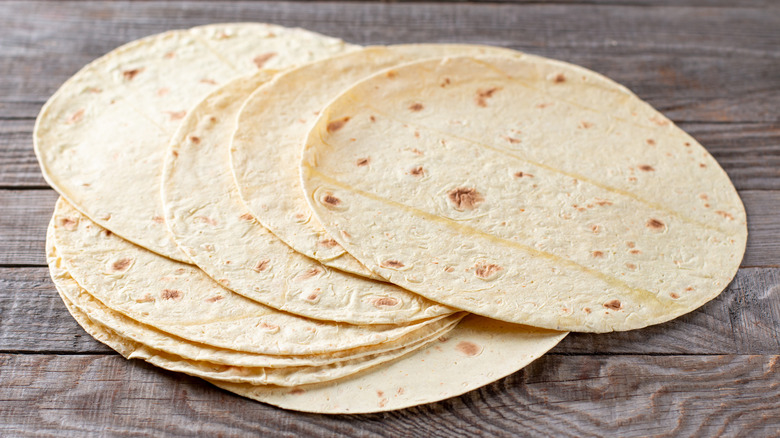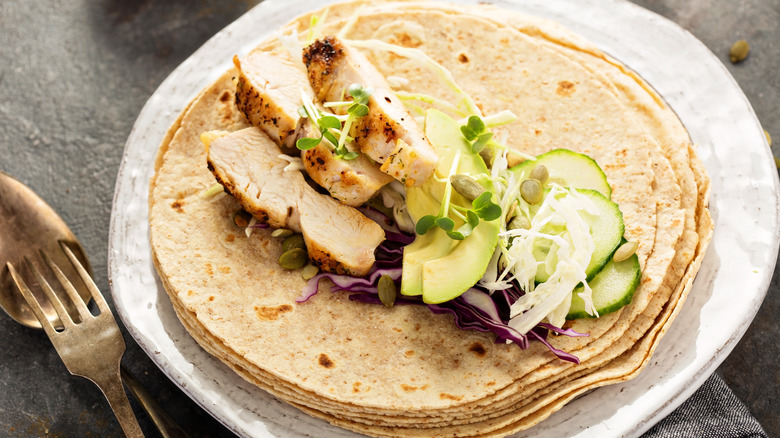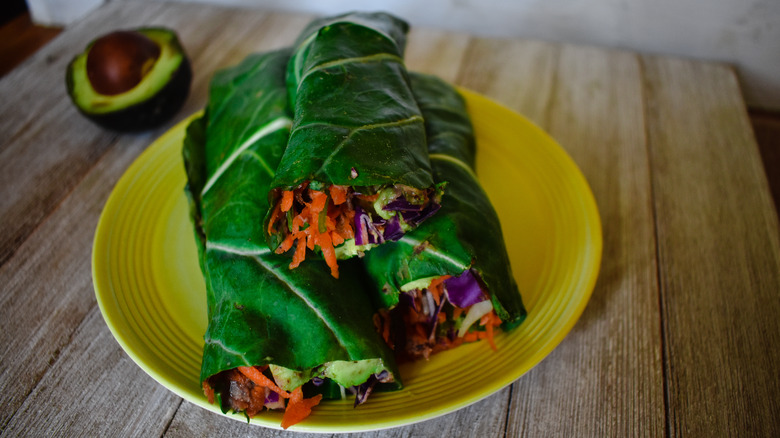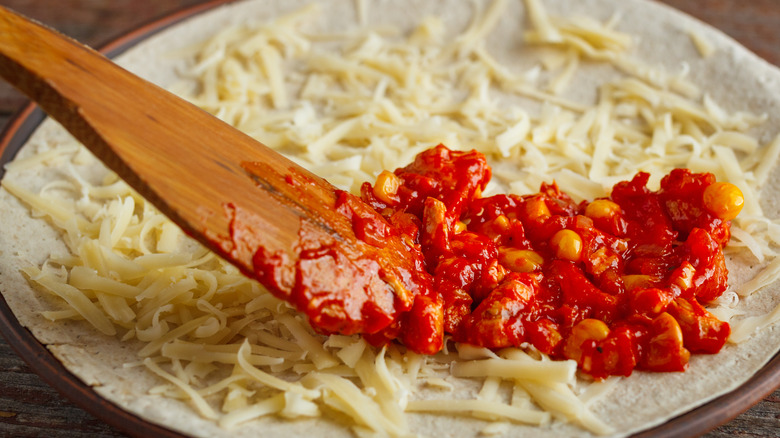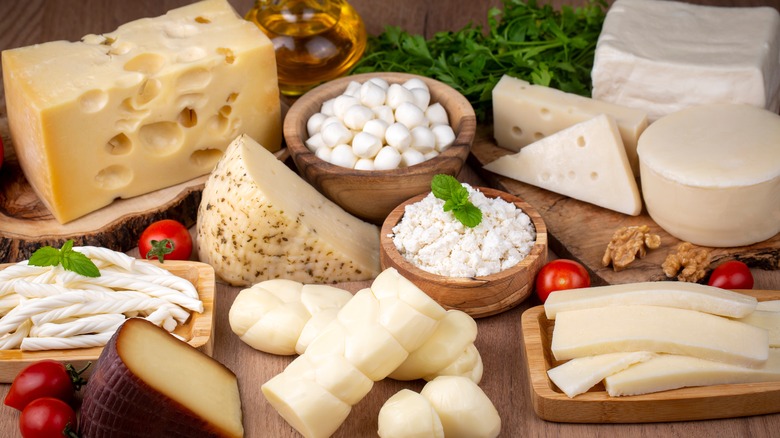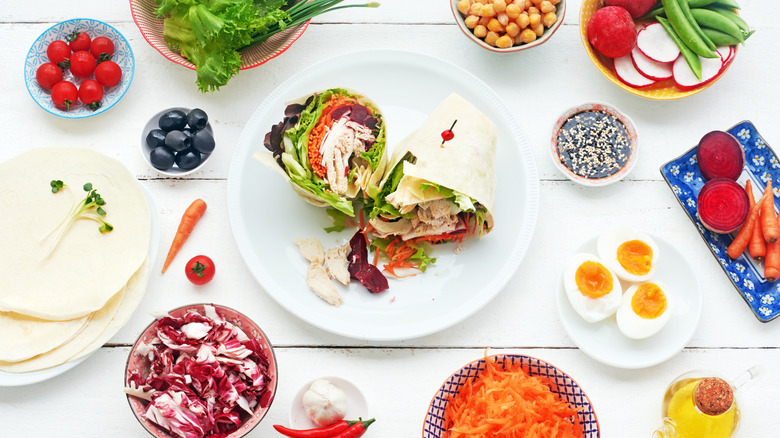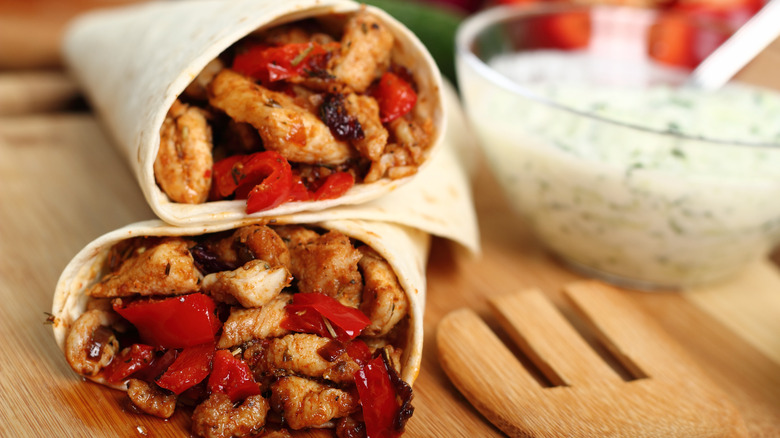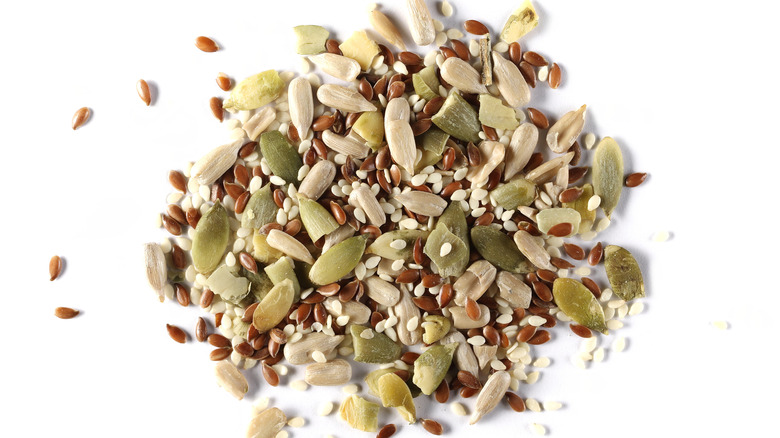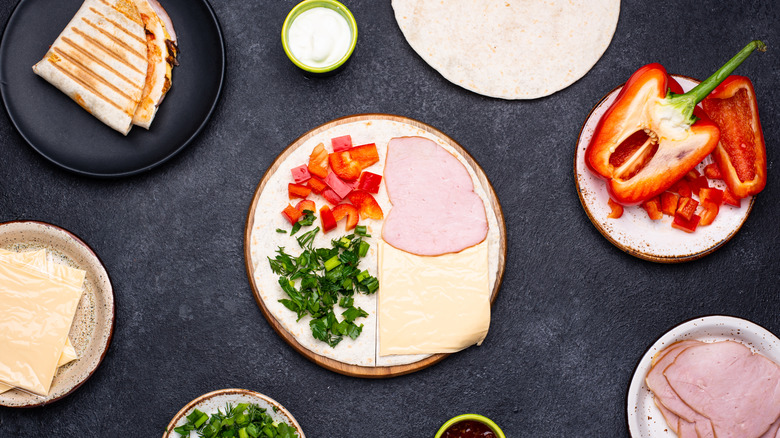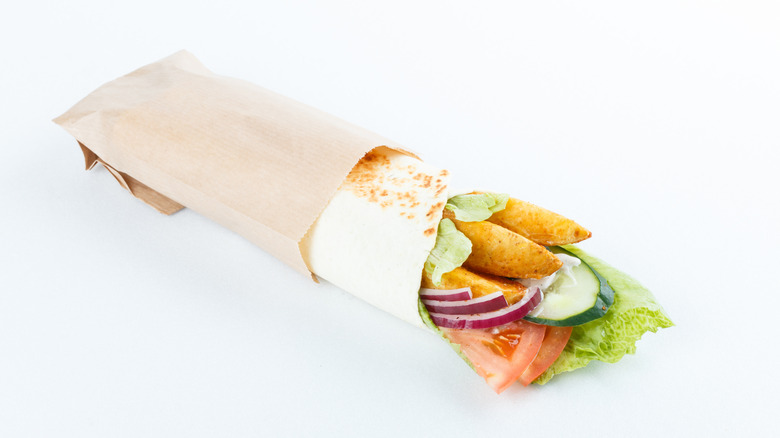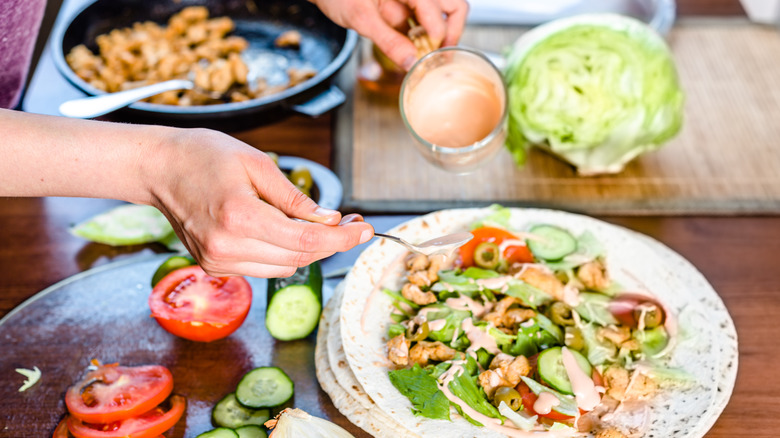15 Mistakes To Avoid With Wraps
Wraps are a great way to enjoy your favorite sandwich fillings without the bread. Traditionally, they are made with tortillas and filled with cold cuts and vegetables; if you can put it between two slices of bread, you can wrap it up in a tortilla.
The beauty of wraps is that they are versatile and appeal to everyone. You can make a healthy version filled with fresh garden veggies or go for a decadent one with breaded protein and lots of creamy ranch. If typical flour tortillas sound boring, wrap your favorite fillings in brightly colored spinach or chipotle tortillas. If you follow a special diet, you can easily customize wraps to fit your needs; if you are trying to maintain a keto or gluten-free meal plan, swap the tortilla entirely and use a leafy green.
For those on a budget, wraps are also an excellent way to use leftovers, and if you regularly eat lunch on the go, know that they will fill your belly without emptying your wallet.
The rising popularity of the morsel seems to have come out of nowhere, but The New York Times credits frugal restaurant owner Bobby Valentine and his broken toaster with its creation. He may have invented the wrap, but he can't take all the praise for how it has transformed into a creative lunchtime favorite. While it seems pretty easy to make, there are a few mistakes to watch out for so you don't ruin your meal.
1. Overfilling the wrap
The most common mistake when making a wrap is overstuffing it. Although your hungry belly and eager eyes may want your tortilla chock full of fillings, it's best not to. It's a recipe for disaster: best-case scenario, the wrap's ingredients seep out of the ends; worst-case scenario, the entire thing falls apart, making a mess and leaving you hungry.
Making a sturdy wrap is an art form, and the first step is to start with a big enough tortilla to fit all the fillings. You should aim for the ingredients to cover ⅓ of its surface (via Toufayan Bakeries). Then evenly spread them out, leaving space at each end for a proper fold.
Don't worry if you don't get it right the first time; it takes a bit of practice to eyeball the right filling-to-tortilla ratio. Just be sure to have plenty of napkins and a spoon on hand to scoop up any goodies that escape.
2. Using a cold wrap
The first step to making any wrap is to warm the tortilla. With a sandwich, you can use toasted bread, but a wrap requires some heat to soften up and make it flexible enough to hold everything inside. Using a cold tortilla will almost certainly ensure that it breaks.
There are a few ways to heat it up, and they all work well. If you have a microwave, you can warm the tortilla in a matter of seconds. But if you prefer to avoid microwaves, try putting it in a skillet or comal on the stove. Just make sure to use a dry pan without any oil. If you like a little smoky flavor and plan on using a corn tortilla, you can warm one up over the open flame of your stove's burner using tongs; flip it over a few times to get a burnt char (via Old El Paso).
3. Choosing a thick wrap
Not all wraps are created equal. Some are too delicate and don't have the structural integrity to hold the savory fillings, and others are too dense to wrap all the way around. So, keep in mind the type of wrap you are making and choose a soft flatbread that is not too thick and not too thin; just like Goldilocks, you want to find the one that is just right.
There are two types of wraps: the classic version that fully encompasses the ingredients and is sealed like a burrito, and the open wrap that holds the filling like a large taco and doesn't completely close. The Greek gyro sandwich is a great example of a non-closing sandwich wrap. It is usually made with thick pita bread or flatbreads, which work great for this style.
But if you are going for a full wrap experience, a flour tortilla, which is much thinner than pita and flatbreads, is your best bet. It comes in a burrito size, which is big enough to seal the wrap and hold a lot of veggies and protein.
4. Forgetting a flavorful spread
On a sandwich, mayonnaise is king, but a wrap deserves more; why use plain old dressing when you can choose flavorful spreads instead? They can set the tone for the theme of the wrap and the type of cuisine you want to embody. Use bright basil pesto for an Italian-inspired version, cross the Mediterranean and use a thick layer of hummus, or go Greek and lay down a smear of tasty garlic-infused tzatziki.
Try a creamy avocado mix if you want a nutritious spread that adds more than just flavor. Avocados are an excellent source of vitamins, minerals, and healthy fats (via healthline).
Classic salad dressings, like tangy honey mustard, are also great for wraps. And if you can handle the heat, add some sriracha mayo for a spicy little kick. A flavorful spread will take a wrap from good to great, so if you want an unforgettable wrap, don't forget it.
5. Using stale wraps
You would never make a sandwich with stale bread; likewise, you should never make a wrap with a stale tortilla. They are usually sold in bags, and when kept in the refrigerator, they can last well beyond their expiration date. But once that bag has been opened, the tortillas can start to go bad, especially if the bag is not properly sealed or stored. Stale tortillas, like stale bread, are dry and bland — so you do not want to ruin your wrap with them.
Luckily, there is a little microwave trick to bring life back to old tortillas, similar to how you revive stale tortilla chips: Cover the tortilla with a damp paper towel and microwave for a minute (Via FoodPrint). Depending on your microwave, you may need to add another 30 seconds for it to soften fully.
Although this trick is great for stale tortillas, it won't fix those that have gone bad. If they have turned moldy with white or green spots, it's time to throw them out.
6. Placing the filling in the middle
Wraps are like real estate; they are all about location — the location of the fillings, to be exact. How you fill your wrap and where the ingredients are placed are key to keeping it from falling apart. If you add all the yummy filling right in the middle, the dish will be disproportionate, and while the center will have all the goodies, the bites at the ends will just be mouthfuls of carbs and none of the good stuff.
Instead, spread the fillings evenly on your tortilla. The best way to do this is to take your round tortilla and make a rectangle with the ingredients in the middle, leaving space around the edges; that way, you can easily fold in the sides and then roll up the rest to make a neat little pocket (via Mahatma).
A good rule of thumb is to ensure all of the chunky pieces in the filling, like the protein, cheese, and veggies, are roughly the same size. That way, each bite is balanced with all of the flavors and textures.
7. Sticking with the same wraps
While wraps are generally made with tortillas — making them a cousin to the Tex-Mex favorite, the burrito — the dish can also be made without them. You can mix it up and try other fun ways to roll up your favorite fillings. Use leafy greens like lettuce, Swiss chard, or collards for the wrap, or add some umami with nori.
While lettuce leaves only need a quick rinse, thicker leafy greens need a little prep before you can use them to wrap up your fillings. The best way to prepare them is to steam them, so they soften up. Make sure to pat them dry before adding filling; otherwise, they will be too wet to hold their shape, and you will be left with a big mess. You should also remove the thick center stem because it is fibrous and bitter, and you don't want that in your wrap.
8. Using too many wet ingredients
Choose your fillings carefully and avoid ingredients that have excess liquid because they will make your wrap soggy. Reach for veggies without a high water content, like crunchy carrots, cabbage, and jicama. And make sure to remove any extra grease from cooked proteins before adding them to your wrap. The best way to use popular fillings like fresh tomatoes, which are very wet, is to remove the seedy membrane and pat them dry with a paper towel. If you like to use fun but wet ingredients like artichokes, olives, and sun dried-tomatoes, place them on a paper towel and squeeze out the excess moisture before using.
Dipping sauces and salsas are great ways to eat wraps but keep them on the side and out of the mix. Just like you would never put salsa inside a breakfast burrito, leave out the side sauces to keep your dish from becoming a mushy mess.
9. Using the wrong cheese
Don't deny it; your wrap needs cheese. Is it really even a meal if there isn't a cheesy component? The best cheese to use with a wrap depends on the temperature. If you are making a cold version with typical sandwich fillings, you will want thinly sliced cheese that will hold its shape, like cheddar, Swiss, or provolone. But if you are preparing a wrap with hot filling, a variety that melts well, like mozzarella or manchego, is best. Shredded cheese also melts easily — just make sure you shred your own and don't use the pre-shredded alternatives, as they have a lot of fillers and additives that prevent proper melting.
Crumbly cheeses like feta and blue cheese are excellent choices for both hot and cold wraps. To keep these varieties from falling out of the wrap, use your favorite spread to anchor them in place so they don't end up in your lap.
10. Adding in unhealthy options
There is a falsehood that ditching bread and using a wrap is healthier. Wraps, like sandwiches, are only as nutritious as the ingredients used to make them. Choosing a whole wheat wrap is one way to keep the dish healthy (via Cleveland Clinic). Whole wheat provides fiber, vitamins, and minerals and is a better alternative than a white flour tortilla.
But how do you fill your wrap to keep it nutritious? Choose a protein like shredded chicken or beef and forgo processed meats like salami, cured ham, and smoked turkey. According to the World Health Organization, processed and cured meats contain carcinogens. Not only that, but they are high in sodium and linked to a higher risk of heart disease and diabetes (via Harvard T.H. Chan School of Public Health).
So, if you want to keep your wrap healthy, get creative and find other proteins to add to it. For example, use rotisserie chicken or thinly sliced Sunday roast. Hummus or other mashed bean dips are excellent options for a plant-based variety, and always pack in your favorite veggies. Don't assume just because you ditched the bread that the wrap is a healthier choice; make it a better choice by choosing your ingredients wisely.
11. Wrapping them too tight or too loose
How you wrap your wraps is just as important as how you fill them. There is a sweet spot when rolling up your ingredients; you don't want to wrap the tortilla too loosely because the savory goodies will fall out. And if you go the other way and wrap it too tight, you risk smooshing all the components together and having them spill out the ends. So, you'll want to wrap slowly and pay attention to where the fillings are laid out.
First, make sure you have the ingredients spread out in the center of the tortilla. Take the bottom part of the tortilla and use it to cover half of the filling, then pull in the two sides and start to roll forward. The sides should tuck in, and the roll should be tight enough to keep everything together. You can use a bit of butter or spread as glue to hold the wrap together. It might take some practice, which is a great excuse to make more wraps.
12. Leaving out the crunch
Texture is an important part of creating a meal; the right or wrong consistency can make or break it. Sandwiches rely on crispy lettuce or fresh sprouts for crunch, but wraps have more wiggle room for similar ingredients. In a wrap, a crunchier texture makes each bite pop and adds to the overall taste experience.
With that said, don't be afraid to add some extras to your wraps, like sunflower seeds or slivered almonds. Sprinkle chopped peanuts into a Thai chicken wrap, or add roasted pumpkin seeds to a veggie-filled wrap.
Not only do nuts and seeds add much-needed texture to the wrap, but they are excellent ways to get more healthy fats and satiating protein into your diet. They are teeming with essential vitamins and minerals (via Better Health Channel). So, don't skimp on these nutritional powerhouses; make sure to add them to your dish.
13. Not trying new ways to fold it
TikTok has given us many gifts in the short time it's been around, from dance videos to life hacks; it is teaching the world new things. And one popular culinary hack from the app is a creative way to fold a wrap.
It's a simple trick, and you don't need any special techniques or fancy tools — just a knife and a heat source like a panini press or skillet. Lay the tortilla out flat and imagine a plus sign going down the middle dividing the tortilla into four sections. Add an ingredient to each section. For example, if you were making a chicken bacon ranch wrap, put the chicken in one area, the ranch in the next, the lettuce in another, and, finally, the bacon in the last quadrant. Next, make one slit from the center of the tortilla along the line of the imaginary plus sign. Then, fold one section on top of the other until you have all the sections layered on top of each other like a wedge. Heat and enjoy while watching more TikTok videos.
14. Not making them portable
Lunch on the go is nothing new in our busy world, and wraps are an excellent on-the-go meal. You can hold them with one hand and eat them while driving or running from meeting to meeting. But the key to making them portable is the outer wrap; you need an outer wrap that will keep everything in place so you can throw it in your bag and eat it on the go.
The best way to make the dish portable is to keep it in parchment paper. Parchment paper is coated in silicone, creating a non-stick surface. It looks similar to wax paper, but the difference is that the latter is coated with a substance that can get in your food or melt when heated. On the contrary, parchment paper is safe to go in the oven or microwave and is a great product to use for food storage. So wrap your tasty meal in parchment paper to keep your lunch fresh and portable.
15. Not making them at home
Many fast food places want to latch on to the healthy eating trend by adding nutritious options to their menus. But these additions often have more calories and unhealthy fats than traditional items. For example, fast food staple Arby's has five wraps on its menu, and while they are marketed as healthy, they are far from it; they range from 530 to 650 calories.
So if you are turning to wraps as a healthier alternative, stick to preparing them at home, where you can control the ingredients list and stick to nutritious and filling items. As a bonus, making your own is a lot cheaper than shelling out for fast food options. And if you love the taste of the fast food variety, prepare a copycat Chick-fil-A Cool Wrap and get the best of both worlds.
Making your own wraps at home is fun, and doing so ahead of time and storing them in your fridge makes them just as convenient to reach for as the ones from the drive-thru.
